When Hurricane Helene Devastated Carolina Native Nursery, the Community Rallied Together to Rebuild
September 18, 2025
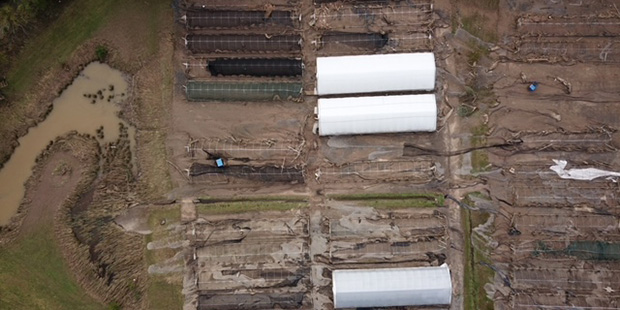
It was a sunny Friday afternoon, September of 2024, when the storm had finally cleared in North Carolina.
Bill Jones drove from his home in Asheville to Carolina Native Nursery, his business in Burnsville, just 30 minutes away.
Although he expected storm damage, he did not expect to find thousands of black pots scattered across the valley or three feet of water still rushing through his shop.
“We’ve had hurricanes come through here before,” Jones said. “But nothing like this.”
Hurricane Helene dropped 30 inches of rain over western North Carolina in just three days. The trout stream that bordered the nursery swelled from 10 feet wide to 100 yards across and five feet deep.
Water tore through the operation — washing away 90% of Carolina Native’s plant inventory, destroying greenhouses, and leaving behind a tangled mess of debris.
Despite running through their hurricane checklist, which includes securing the property and ensuring there aren’t logs in the trout stream or feeder creek, nothing could have prepared the property for what was to come.
“The plants were gone, a lot of the gravel was gone, many of our greenhouses were either damaged or destroyed, and so it left us with just piles of stuff,” Jones said. “You can’t stop water like that. There’s just no physical way to do it.”
Jones tried to reach the nursery on three different roads that Friday. What he found was total devastation.
“We had to climb through downed trees,” he said.
Not only was their shrub yard and perennial farm destroyed, but the road above the nursery suffered a landslide, damaging the top of the property, and the bottom of the property had been washed away.
“All the phone lines were down, all the power was out. I tried to go find a woman who works here and is part-owner of the nursery — I couldn’t find her, I couldn’t get to her house,” he said.
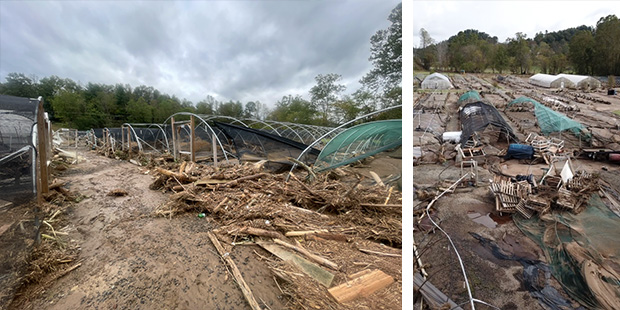
Feeling helpless, that’s when Jones and his wife got back in their car and went home because at that point “there was absolutely nothing we could do,” he said.
Where to Go From Here?
Before the rebuild, filing an insurance claim was imperative. “Luckily, we have crop insurance,” Jones said. “Without the crop insurance we had, we never would have been able to afford to bring in all the stock to replant.”
By Thursday of the first week, volunteers began arriving. Landscape firms closed for the day and brought equipment.
“We had over 100 people out here helping us get all the trash out,” Jones said. “It was sort of helter-skelter at first, but we started our rebuild and we’ve been working on that ever since.”
Lost Inventory and The Community’s Response
Some plants survived — a few thousand up the hill were out of the flood’s reach. But others had gotten an inch or two of water in the base of the pot.
Even though those plants were salvageable, the Department of Agriculture deems them unsellable once they’ve sat in flood water.
For those plants, Jones and his team set up a donation program.
“We ended up donating well over 6,000 plants to nonprofits and volunteer groups trying to replant people’s stream banks and gardens,” Jones said. “That ended up being a beautiful thing.”
Jones doesn’t know how they could have gotten to where they are now without over 100 volunteers helping to pick up the property.
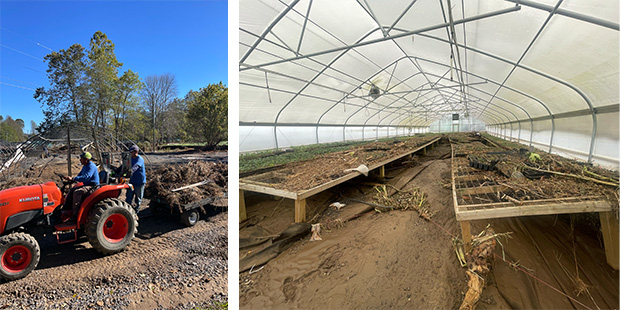 The community support, he said, was humbling.
The community support, he said, was humbling.
“As an entrepreneur, you’re used to doing it yourself,” Jones said. “My wife was like, ‘You’ve got to accept these people’s help and let the volunteers come because all these people want to do it.’”
Jones partially attributes the outpouring of volunteers to the one-of-a-kind products Carolina Native offers.
“We are the native nursery that services this whole geographic area — the landscapers, the garden centers — and we’re sort of irreplaceable in the plant palette that we grow,” he said. “People needed us back up and running because they need what we have to do their work.”
The nursery launched a GoFundMe campaign that raised $150,000 and even received checks in the mail from strangers.
“In the long run, I think it’s made me a much more grateful and humble person,” he said of the support they received from all over the country.
A Three-Year Recovery
Jones estimates the nursery suffered about $2 million in damages. Crop insurance — a federally supported program he urges all growers to look into — covered roughly half of that value.
The nursery lost fourth-quarter sales last year and much of the spring season this year. But sales have now rebounded. Staffing has returned. Facilities are nearly rebuilt.
“With our perennials and our shrubs, we’ve recovered tremendously in sales,” Jones said. “With the azaleas, it’s going to be a while. But sales-wise, we’re in really good shape.”
Among the hardest losses to absorb were Carolina Native’s native azaleas — a specialty crop that Jones’ team grows from seed.
“We harvest the seed late in the fall, right after Thanksgiving,” Jones explained. “Then we grow the seedlings into liner trays the first year, into 1-gallons the second year, and 3-gallons the third.”
The nursery had tens of thousands of native azaleas on the ground across all stages — and lost nearly all of them.
“All the 1-gallons and 3-gallons were gone. A lot of our liner stock was gone,” Jones said.
With 13 species of native azaleas indigenous to the eastern U.S., Carolina Native is the largest grower of these plants in the country (they sell all 13). And because they can’t outsource this part of the business, rebuilding stock will take time.
“It’s going to be a two- to three-year process,” Jones said.
Meanwhile, the nursery’s perennials, ferns, grasses, and other native shrubs — sourced from outside growers — have bounced back quickly.
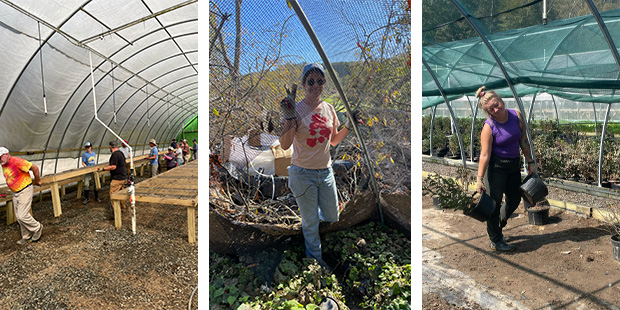 “We already had those orders in the hopper,” he said. “So all that stuff we’re up and running on.”
“We already had those orders in the hopper,” he said. “So all that stuff we’re up and running on.”
Same Mission, New Perspective
Despite the upheaval, the nursery’s mission hasn’t changed.
“We grow beautiful, high-quality native plants for IGCs and landscapers,” Jones said.
He has no plans to change locations, either.
“In western North Carolina, the only flat land is near streams and rivers, and that’s where we are. We’re not moving,” he said. “We love western North Carolina. I sold my organic lawn and shrub care company in Charlotte to move up here to do this and raise our kids in the mountains.”
That commitment to place — and to the people they serve — has paid off.
“Whether [our clients] are wholesale or retail, garden centers or landscapers, they’ve come roaring back,” he said. “They were just waiting for us. They didn’t turn and start buying from other nurseries.”
Advice to Other Growers
Having gone through Hurricane Helene, what advice does Bill have for other growers, particularly those in vulnerable regions?
“If you haven’t examined crop insurance and put that as an expense line, it will save your business,” Jones said. “It’s a federal program that is available to everyone who grows a crop.”
“And secondly, if you are met with disaster and people want to volunteer to help, let them. You can do it all yourself. But why? It makes you feel good. It makes them feel good.”
Today, Carolina Native is almost totally renovated. There are just a couple of greenhouses at the corner of the nursery to rebuild that Jones likens to “having one room left to paint before being done with the house.”
But ultimately, he’s incredibly proud to have gotten back to mostly normal operations after such a devastating blow from Hurricane Helene.
“We’re just so happy to be selling plants again,” Jones said. “And that’s what everybody’s working on, either growing or selling. We’re just so grateful to everybody that’s helped us.“
At Willoway Nurseries, Smarter Spraying Means Better Labor Use and Healthier Plants
July 7, 2025
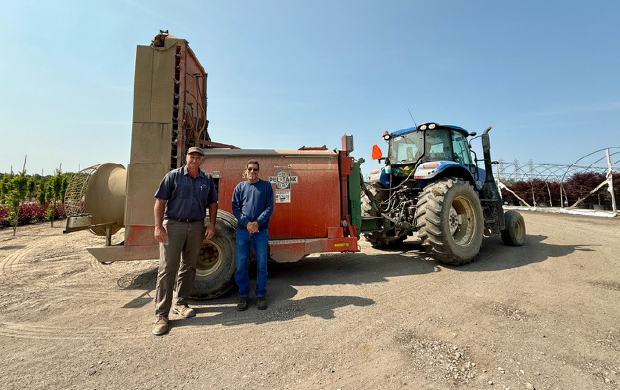
Thad Kohlenberg (left), Will Mihalega (right), and Willoway’s first-generation smart sprayer
At Willoway Nurseries in Avon, Ohio, better spray technology is translating directly into healthier, more resilient plants.
This smarter, more precise approach to spray application is not only improving plant performance but also folding staff back into the nursery to perform more strategic work.
On a recent visit, their team walked us through three newer technologies in their spray lineup: a Birchmeier backpack, a Gandy granular applicator, and the centerpiece: a “smart sprayer” developed with the USDA.
Replacing the Guesswork in Spray Application
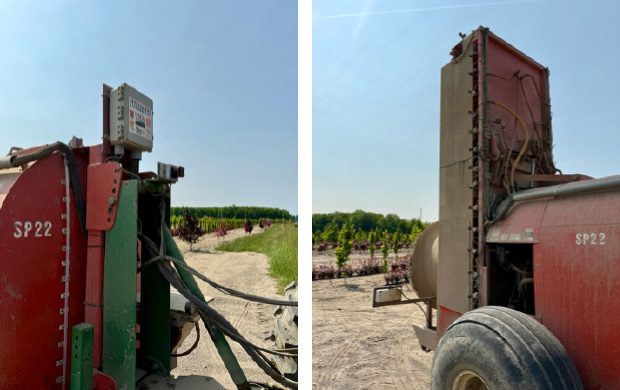
Willoway was one of the first growers to test the USDA’s smart sprayer system. The first version uses laser sensors to detect when a tree is present.
Each spray nozzle is controlled by an electric solenoid that adjusts in real time based on tractor speed and canopy size.
You can have taller trees on the left and shorter ones on the right, and it adjusts on the fly, explained Head Grower Manager Thad Kohlenberg.
Despite the sprayer’s advanced capabilities, it’s been easy to use.
“It’s just a basic iPad up there. There’s nothing really technical to operate,” said Will Mihalega, who oversees plant health. “It’s all pretty simplified.”
And that’s just the first generation.
Version two – a system that scans canopy shape using imaging instead of lasers – made application even more optimized.
“A camera takes thousands of images, and you can make a digital representation of the
actual pattern of the branching, and it adjusts the sprays to that,” said Kohlenberg.
“It takes the silhouette of the tree and only sprays the silhouette,” described Ben Averitt, Staff Horticulturalist – R&D at Willoway.
The third generation is more versatile. It’s smaller, lighter, and modular, designed without a power take-off (PTO) so it can mount on lighter vehicles and navigate tighter rows.
A Toolkit of Sprayers
The smart sprayer isn’t doing it all alone. Willoway also uses an Orbit-Air Gandy granular applicator, a converted seeder with a 24-foot boom and air assist blower, to apply pre-emergent herbicide across field rows.
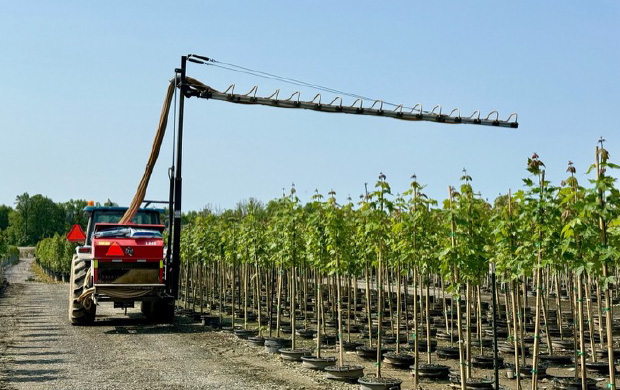
Before they started using the Gandy three years ago, five workers went up and down the rows wearing a respirator mask, each covering 11 miles a day.
Now the Gandy, operated by one person, can do the job in the same amount of time.
“It puts the most perfect pattern across that area,” said Mihalega.
The granules on the herbicides were so fine that they were nearly invisible coming out of the nozzles.
“You can see [it’s] even all the way across if you look at the pot,” Kohlenberg said.
Not only does the Gandy applicator deliver an ultra-consistent pattern, it’s also dramatically improved weed suppression.
“The weed control is so much better. We used to have sporadic weeds in there,” Mihalega pointed out. “Now it’s just crystal clean.”
Their third go-to tool is the Birchmeier backpack sprayer, a compact, air-assisted tool ideal for tight greenhouses and property edges.
“It’s basically a little air blast in your hand,” Mihalega said.
The team uses it to target areas a big tractor can’t reach – like under bamboo stakes or along neighboring property lines – without risking chemical drift.
“It’s got a handle [where] you can turn the fan up and down to suit different distances,” Kohlenberg added. “And also, you can change the droplet size on it.”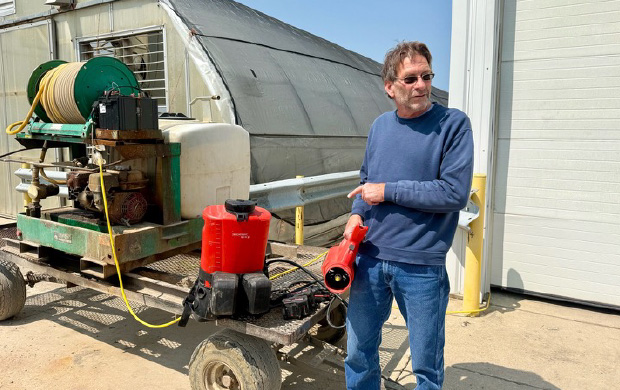
Tech That Pays Off Every Day
For a nursery operating at Willoway’s scale, the benefits are straightforward: smarter spraying frees up skilled labor, offers better consistency, and produces healthier plants.
“It’s one of the things that people are most interested in when they visit,” said Kohlenberg. “It’s not highly adapted in the industry, but it’s probably something everybody should be looking at for the investment.”
These tools are helping nurseries become more efficient in the constant push to do more with less.
In the past five years, Willoway’s labor expenses have jumped 45%. Smarter spraying gives them the flexibility to continue operating efficiently… even grow.
As the nursery scales up use of biological controls, sensor-driven fertigation, and degree-day pest prediction, they are seeing healthier crops, fewer inputs, and more consistent production.
“It comes back to sustainability – reducing our cost of imports for producing a plant,” said Kohlenberg. “And then we’re getting better results with the application and [reducing] wear and tear on guys.”
Willoway’s Secret to Moving 36,000 Hydrangeas? Six Driverless Burros
June 20, 2025
You might find yourself doing a double take at Willoway Nurseries in Avon, Ohio, where self-driving vehicles are the new norm.
Spread across 1,000 acres, the operation recently deployed six autonomous tractors from a Philly-based company called Burro, and their impact on efficiency has been immediate.The Burros arrived in spring and are already proving to be reliable haulers in the nursery’s canning process, delivering newly potted plant material to designated drop-off points. 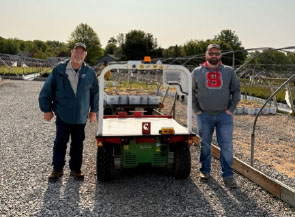 “We got a fleet of six of them back in March,” said Willoway’s Staff Horticulturist – R&D, Ben Averitt. “We’ve mostly been using them for our canning process, for delivering newly canned material to the set downs.” Each unit runs on preprogrammed routes built from drone-generated maps and custom overlays. It’s a setup that takes time to establish, but once in place, the system becomes intuitive. “It’s a slow process, but then once you have it all drawn, you punch in the location you want it to go to and it finds the best route to get there based on the information it has,” Averitt explained.
“We got a fleet of six of them back in March,” said Willoway’s Staff Horticulturist – R&D, Ben Averitt. “We’ve mostly been using them for our canning process, for delivering newly canned material to the set downs.” Each unit runs on preprogrammed routes built from drone-generated maps and custom overlays. It’s a setup that takes time to establish, but once in place, the system becomes intuitive. “It’s a slow process, but then once you have it all drawn, you punch in the location you want it to go to and it finds the best route to get there based on the information it has,” Averitt explained.
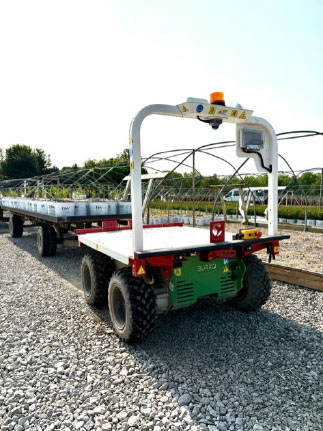 For light loads, speed is intentionally limited to about 2.5 miles per hour to prevent plants from jostling off tractor beds during transport. Still, even at that speed, the Burros are making a difference. “It’s saving us a body moving back and forth on a tractor,” Averitt noted. The labor efficiency afforded by the Burros has been massive. Add in a forklift for unloading and “now we’ve taken a four-guy process down to one guy,” said Averitt. The other three workers, now freed up from repetitive driving, are deployed to higher-value nursery work like trimming, spacing, and fertilizing. Besides their efficiency, the Burros are clever and surprisingly interactive. Outfitted with sensors, they can detect obstacles within six feet, stop at intersections, and emit a short honk as a safety measure.
For light loads, speed is intentionally limited to about 2.5 miles per hour to prevent plants from jostling off tractor beds during transport. Still, even at that speed, the Burros are making a difference. “It’s saving us a body moving back and forth on a tractor,” Averitt noted. The labor efficiency afforded by the Burros has been massive. Add in a forklift for unloading and “now we’ve taken a four-guy process down to one guy,” said Averitt. The other three workers, now freed up from repetitive driving, are deployed to higher-value nursery work like trimming, spacing, and fertilizing. Besides their efficiency, the Burros are clever and surprisingly interactive. Outfitted with sensors, they can detect obstacles within six feet, stop at intersections, and emit a short honk as a safety measure.  They can also follow a worker around the nursery, a feature Averitt likened to “a little puppy dog.” Currently, each unit must be manually started every morning, but updates are on the horizon. An autonomous docking station is in development, which will allow the Burros to charge themselves overnight and begin work on a preset schedule. “We’ll be able to home, dock, plug in, and then [it can] unplug itself. Say, six o’clock in the morning, you want it up and running, and bam, there it is,” Averitt said.
They can also follow a worker around the nursery, a feature Averitt likened to “a little puppy dog.” Currently, each unit must be manually started every morning, but updates are on the horizon. An autonomous docking station is in development, which will allow the Burros to charge themselves overnight and begin work on a preset schedule. “We’ll be able to home, dock, plug in, and then [it can] unplug itself. Say, six o’clock in the morning, you want it up and running, and bam, there it is,” Averitt said.
In terms of strength, the Burro Grande is rated to tow up to 5,000 pounds, though the Willoway team has tested it with loads up to 9,000 pounds with no complaints. Recently during a large contract order, the Burros moved 36,000 hydrangeas with remarkable speed and consistency. “We set up a superhighway for them,” Averitt said. “It was a slick setup.” The company is already planning further tech integrations. RFID tagging is being explored for real-time inventory mapping, and one of the Burros will soon be fitted with a mower. There’s also potential to attach sensors for thermal mapping and monitoring heaters in the winter. Willoway is one of the first nurseries in the country to use this technology, receiving the hundredth Burro ever produced.
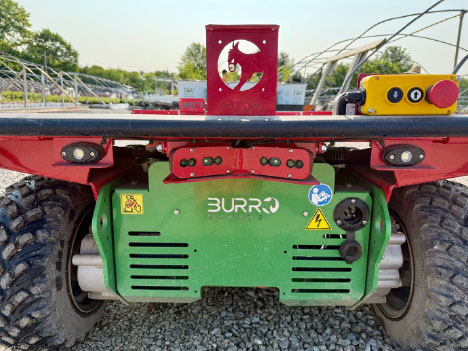 Their property is also the largest operation the machines have been deployed on to date. Willoway’s early adoption and expansive footprint has made it a pioneer in the industry, a case study for integrating automation. Learning to use the Burros has been relatively easy. Averitt estimated that most staff are up and running with the system in about two hours. One of the company’s H-2A workers has become the in-house expert, regularly updating maps on his phone and helping others navigate the system. As with any new tool, there’s been a cultural adjustment. Averitt laughed when recalling some of the early reactions. “One of our biggest issues was that people wanted to pet them,” he said.
Their property is also the largest operation the machines have been deployed on to date. Willoway’s early adoption and expansive footprint has made it a pioneer in the industry, a case study for integrating automation. Learning to use the Burros has been relatively easy. Averitt estimated that most staff are up and running with the system in about two hours. One of the company’s H-2A workers has become the in-house expert, regularly updating maps on his phone and helping others navigate the system. As with any new tool, there’s been a cultural adjustment. Averitt laughed when recalling some of the early reactions. “One of our biggest issues was that people wanted to pet them,” he said. 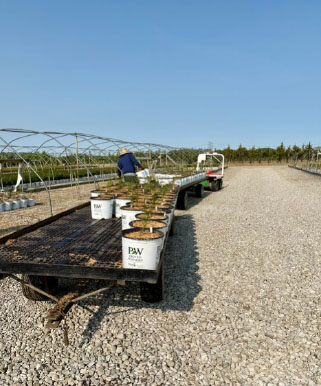 “There’s a lot of jokes about who’s the real burro—the machine or the guys. ” Jokes aside, the benefit is clear. “When these things are working, which is 90% of the time, they’re awesome,” Averitt said. “We can cook with peanut oil with these things.”
“There’s a lot of jokes about who’s the real burro—the machine or the guys. ” Jokes aside, the benefit is clear. “When these things are working, which is 90% of the time, they’re awesome,” Averitt said. “We can cook with peanut oil with these things.”
Automation isn’t replacing workers at Willoway, it’s allowing them to do more specialized tasks. And on a 1,000-acre nursery with no time to waste, that kind of ROI speaks for itself. “The whole goal is to take out the mindless work,” Averitt said. “What these guys are really good at is their job. Why have to drive a tractor?”
Visit Willoway Nurseries and learn more about their new burro buddies!
AMGUARD Strengthens U.S. Specialty Markets Team
June 19, 2025
Two promotions and four new hires demonstrate commitment to AMGUARD and OHP specialty market customers
RESEARCH TRIANGLE PARK, North Carolina | June 18, 2025 – AMGUARD™ Environmental Technologies (“AMGUARD”), the specialty markets division of AMVAC Chemical Corporation, a wholly owned subsidiary of American Vanguard Corporation (“AVD”), is pleased to announce six appointments to bolster its commitment to serving US specialty market customers.
Frank Fornari was promoted from OHP Technical Sales Manager to Director of Sales. Frank has been responsible for achieving record-setting nursery and greenhouse sales performance in Florida and Alabama. Prior to OHP, he worked in the specialty markets with BASF and Valent. In his new role, Frank will be responsible for growing and managing the ornamentals and Controlled Environmental Agriculture (CEA) businesses.
Sam Drahn was promoted from OHP Technical Manager to Director of Technical Services. Sam has been responsible for providing technical support and messaging for plant growth regulators (PGRs), herbicides, and specialty products to technical sales managers, growers, and distributors. In his new role, Sam will also provide technical support and messaging for insecticides and fungicides. Sam began his career working as a grower / propagator with one of the largest nurseries in the country, ultimately serving as Director of Research & Development across all locations. Prior to OHP, Sam spent nine years as Director of Research with a chemical manufacturer in the landscape and arboriculture markets. Sam is highly skilled in managing cooperatives and in-field researchers for both national and international projects.
Eric Ham joined AMGUARD as Midwest Technical Sales Manager. In this role, he will cover structural pest control in KY, OH, IN, IL, MI, and TN. Eric most recently was Key Account Manager for the Midwest and South regions with FMC Professional Solutions. Prior to that, Eric served as a Marketing Specialist with FMC for nine years. Eric also has experience with Nisus Corporation and Forshaw Distribution. He holds a bachelor’s degree in agriculture – entomology from the University of Kentucky. Eric is a certified applicator in Kentucky and Ohio and holds a pest control license in Kentucky. Ham will report to Ryan Klein, AMGUARD Director of Sales.
Joe Grippi joined OHP as Southeast Technical Sales Manager. In this role, he will be responsible for the market development and sales of OHP products, including fungicides, herbicides, insecticides, and plant growth regulators in the Greenhouse, Nursey, and Controlled Environment Agriculture (CEA) markets. Joe was most recently with UPL Environmental Solutions as a Key Account Manager for Specialty Products. Prior to UPL, he was Business Development Key Account Manager with Bayer Environmental Science / Envu, where he served for 22 years. Joe started his career at Elf Atochem and American Cyanamid.
Jeremy Sanderson joined OHP as Northeast Technical Sales Manager. In this role, he will be responsible for the market development and sales of OHP products, including fungicides, herbicides, insecticides, and plant growth regulators in the Greenhouse, Nursey, and Controlled Environment Agriculture (CEA) markets. Jeremy spent over five years at BioWorks, where he led sales operations, grew the Soil Blender business, and supported key accounts, including Hawaiian coffee growers. He also held regional sales roles with Harris Seeds and Harvest Moon Hydroponics, and he ran his own consulting business, Hybrid Horticulture.
Grippi and Sanderson will report to Frank Fornari, OHP Director of Sales.
Eric Rebek, Ph.D. joined OHP as Technical Services Specialist. In this role, he will lead and assist with creating and managing technical projects, protocols, and data in service to developing products and technical information for the dissemination to the OHP team, our partners, customers, and growers in the Nursery, Greenhouse, CEA, and Cannabis markets. Eric’s position will focus primarily on entomological and pathological issues to support OHP’s plant health & production portfolio (insecticides, fungicides, herbicides, PGRs and specialty products). Rebek will report to Sam Drahn, OHP Director of Technical Services.
“With Frank and Sam at the helm, expanded service in the Southeast and Northeast, and additional technical support, OHP is poised to deliver exceptional service to our greenhouse and ornamental, nursery, CEA, and cannabis customers,” said Shayne M. Wetherall, CEO of AMGUARD and President of U.S. Specialty Markets. “Additionally, the addition of Eric Ham strengths our commercial presence for structural pest control in the Midwest.”
About AMGUARD Environmental Technologies
AMGUARD Environmental Technologies is an emerging provider of non-crop and specialty technology solutions for the U.S. Public Health, Pest Control, Ornamental & Greenhouse, Golf, Lawn & Landscape, Foodservice, and Consumer markets. We are the specialty markets division of AMVAC Chemical Corporation, a wholly owned subsidiary of American Vanguard Corporation. From our RTP headquarters and labs, AMGUARD discovers, develops, and commercializes a diverse portfolio of proven chemistries, innovative technologies, and green solutions into diverse markets. At our core, we are innovators. We are committed to protecting the population from disease vectors, mitigating structural pest damage, creating healthy foodservice environments and outdoor living spaces, and maintaining outdoor sports and recreation venues. Our mission is to provide our customers with powerful technology solutions to keep their businesses strong and growing. www.AMGUARDTECH.com
About OHP
OHP Inc, originally Olympic Horticultural Products, was founded with the goal of becoming the leading provider of technology-based pesticide solutions for the greenhouse and nursery production markets. Today, as we have evolved into our new OHP identity we are recognized as the leader in this market. The OHP team exclusively markets our products, specifically packaged and labeled for the greenhouse and nursery production markets, through a network of leading distribution partners throughout the United States and Puerto Rico. www.ohp.com/
About American Vanguard
American Vanguard Corporation is a diversified specialty and agricultural products company that develops and markets productsfor crop protection and management,turfand ornamentalsmanagement and publicand animal health. American Vanguard is included on the Russell 2000®and Russell 3000®Indexes and the S&P SmallCap 600®Index. To learn more aboutAmerican Vanguard,please reference the Company’s website at www.American-Vanguard.com.
Contact InformationAMGUARDEnvironmental Technologies
Shayne M.Wetherall, CEO& President, U.S. Specialty Markets
(919) 415-4360
ShayneW@amguardtech.com
5151 McCrimmon Parkway, Ste.275 Morrisville, NC 27560 | Amguardtech.com | (888)462-6822
Plantpeddler’s Poinsettia Playbook: From Trials to Timely Delivery
January 24, 2025
The poinsettia season may unfold in the final months of the year, yet it’s often a year-round planning process for growers of any size.
At Plantpeddler in Cresco, Iowa, the work begins long before the holiday rush.
In fact, the team invests months in varietal trials, capacity mapping, and perfecting greenhouse routines to ship a reliable, eye-catching crop on time. Some of the most important lessons learned during poinsettia production can improve workflow across the greenhouse, all year long.
Plan Ahead with the Market in Mind
Poinsettias are unique among seasonal crops because they can occupy greenhouse space for up to six or seven months, much longer than, say, geraniums.
According to Plantpeddler’s general manager Jason Sbiral, poinsettia rooting begins with pretty good numbers in May. Continuing through June and July, he and his team oversee production of the poinsettia liners. All told, Plantpeddler will root several million poinsettias for shipment to greenhouses across the US. Plantpeddler also grows out over 136,000 poinsettias for wholesale sales as pre-finished and finished, to growers and retailers, for holiday sales.
This long lead-up means Plantpeddler needs to forecast capacity and labor demands well before the busy fourth quarter.
One way that Plantpeddler navigated the question of capacity in 2024 was to develop a system on their Metazet FormFlex equipment to produce some eight-inch poinsettias in the air. This added another few thousand plants on top of typical production numbers across both greenhouse locations.
“Most of us have basket capacity overhead, but only produce with it during the spring cycle, though we use ours for some fall production, as well,” John Gooder, COO, says. “So, we’re looking at ways to create an income stream off of that infrastructure that’s already in place.”
Variety Selection and the Influence of Trials
Plantpeddler hosts a comprehensive Poinsettia Trial each year, evaluating more than 200 varieties from around the world. (The company’s 2025 Poinsettia Variety Day will take place Dec. 4, so mark your calendar now.)
This is a major event, international in scope, that draws breeders and growers from around the world to Iowa at the height of poinsettia season. The benefit for the Gooders and their team is that they get a front-row seat to the finest genetics emerging in the marketplace.
This trial environment allows the team to identify high-performing varieties for greenhouse performance, retail shelf life, and post-harvest longevity. Selections prioritize branching, bract color, Cyathia, and ease of production; important factors for a fragile crop that sees heavy handling during shipping.
Painted and Specialty Poinsettias
Perhaps Plantpeddler’s most notable differentiator is that 60% of its poinsettias are upgraded with paint and other “bling.” “That’s paint, glitter, shimmers, specialty treatments. All hand-painted,” Mike Gooder, president, says.
Painting introduces a host of considerations regarding bract shape and color, and thus the team seeks varieties that can withstand those meticulous hand-crafted touches during production.
“A variety might be terrific in the standard sales,” Sbiral says, “but as soon as you paint it, maybe it has some complications. We’re actually not just choosing for a great looking plant, we’re choosing for a plant that looks good, but also accepts paint.”
Those production dynamics are at play along each step of the variety selection process.
The commodity poinsettia market, largely driven by retailers’ expectations for traditional colors (primarily red, with some white and pink), remains strong. So, a high-quality, multi-bract plant is essential. In the grocery and traditional retail sector, a “premium” poinsettia typically means at least five good-sized bracts on a 6.5-inch pot. The industry standard provides a benchmark: If a variety produces many small bracts, it sacrifices bloom size; conversely, fewer bracts may yield larger individual blooms.
Balancing branch count and bract size is critical to meeting retailer expectations without compromising overall plant quality.
However, Plantpeddler and its retail base increasingly see strong potential in specialty poinsettias—new varieties, painted options, and unique forms—that can create market differentiation and wider consumer appeal. By offering both standard colors and innovative novelty programs, growers can increase retail interest and educate consumers on the broader possibilities of poinsettias.
Growers have an opportunity to move beyond commodity red poinsettias and explore distinctive varieties and treatments that ultimately expand the marketplace–and that work begins in proper variety selection.
By developing a clear process—and choosing genetics that can handle the extra work—Plantpeddler expands retail demand beyond classic red, white, and pink poinsettias.
Greenhouse Management: From Start to Finish
Uniformity is a key concept repeated by the team.
In fact, in poinsettias, uniformity is the guiding principle.
“If you have unevenness in your young plant going into poinsettia production, your chances of coming out on the backside with a quality crop are really low,” John says. “It’s those first two weeks of poinsettia establishment that really make or break the crop.”
To push early growth without overextending plants, Sbiral pulls multiple levers in his control: “You feed and give ample amounts of nutrition and water but also manipulate the plants with temperature–like a growth regulator situation”.
Plantpeddler has also shifted toward biorational tools for both pest management and root health.
“We’ve gone a lot more toward biorationals, even bio-pesticide,” Sbiral says. “We’re not 100% bio for pest control, but many of our customers are. So I am conscientious about products that will be compatible. With their bio programs.”
Lessons Learned and Adaptability
Because poinsettias are so tightly tied to holiday sales, on-time delivery is essential. With modern genetics and good production practices, during the season, there is minimal cherry-picking and downgrades.
“You can tell if you’re in good poinsettia season because the team is pulling poinsettias by the bench,” Mike says.
Even with careful planning, the grower must adapt to weather swings and cultural nuances.
“We had a really great poinsettia year in 2024,” Sbiral says. “But next year, I could do everything the same as I did this year and have a completely different outcome. The key is to observe the plants and be fluid. Make changes on the fly.”
His point underscores the reality of horticulture: Fine-tuned methods must still bend to unforeseen conditions.
Conclusion
Whether producing thousands of painted poinsettias or sticking to the commodity side of the market, poinsettias demand skilled planning and execution.
By conducting detailed variety trials, refining greenhouse protocols, and tapping into unique value-added offerings, Plantpeddler demonstrates how specialization can pay off in the busy holiday season.
As Mike says, “Poinsettias are like a one-shot crop. Without a strong beginning, it’s very difficult to finish well.”
A strong foundation and the willingness to innovate are at the heart of Plantpeddler’s approach—keys any greenhouse or nursery grower might keep in mind, poinsettia season or not.